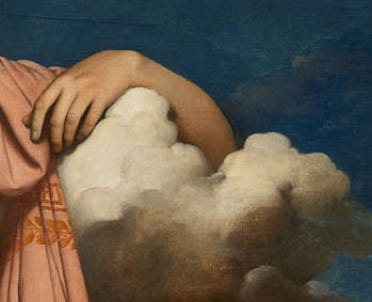This painting by the French artist Ingres depicts a scene from Homer’s Illiad, in which the sea nymph Thetis implores Jupiter to spare the life of her son Achilles. Jupiter’s wife Hera watches him from the sidelines, as well as an Imperial eagle. Thetis extends her arms to caress his knee and stroke his beard, but Jupiter stares straight ahead, ignoring her pleading.
There are many intriguing details about this painting.
For example, consider the way Jupiter rests his left arm on a surprisingly solid cloud.
Or the way that Thetis rubs her toe up against his left foot.
And then there’s Jupiter’s curious facial expression. The French art critic Charles Blanc described it as “at once formidable and deeply sad."
But the real focus lies in the pose. It’s an intentionally erotic scene, taken verbatim from Homer.
“(Thetis), clasping his (Zeus’) knees with one hand and brushing his chin with the other”.
Everything about this painting is strange. As the French author Baudelaire (a contemporary of Ingres, and himself no stranger to artistic provocation) wrote, Ingres had painted something “stranger than anything art has produced”.
Of course Ingres knew exactly what he was doing. He had become known as a classicist, but his sensibilities were more modern.
Writing to a friend on Christmas day, during a holiday in Rome, he said that he’d come up with an idea that would “smell of ambrosia” and that even “the rabid dogs who wish to maul me” (i.e. his critics) would be moved by it.
But the painting proved to be highly controversial. Audiences couldn’t put their finger on what they disliked about it, but something felt off. Of course this was the intention. Ingres wanted to push people off balance. Even the sky has a strange tint to it. It was originally purchased by the French State, but was considered too controversial and returned to Ingres. 23 years later the State purchased it from him again. Times had changed, and it was now considered a major work. As Schopenhauer once joked, genius always evolves in three stages. First it is ignored, then it is mocked, and finally it is accepted as self-evident.
The Italian writer Roberto Calasso described Jupiter and Thetis as “an impossible couple”. Jupiter had desired Thetis, but prophecy foretold that their offspring would one day become more powerful than he, and so he refused her. In this painting, she returns to him, and he -the virile God- is caught between desire and will. In this he reminds us of Wagner’s “Wotan”, a God who traps himself in the contradictions of passion and Law. He is reduced, made small, precisely because he aspires to grandeur.
In this we can see Ingres’ radical contribution to classicism. Against the expectations of the French Academy in Rome (for whom he painted Jupiter and Thetis), he created a strikingly atonal, jarring, even perplexing work. And yet in so doing he launched what can only be considered a revolution in classicism: a painting that defies the conventions of the genre and yet in so doing expands its possibilities. It is as if the artist is inviting us to look again, to take note, and to allow ourselves to be surprised by antiquity in a way we might have forgotten was even possible in the first place.
Yes it is a strange painting, but a wonderful one.
Julian
Thank you for reading my newsletter. My goal is to make learning about Fine Art easy and accessible. If you’d like to support my work please consider becoming a paying subscriber. Thank you so much.









I love this piece, thanks for sharing.